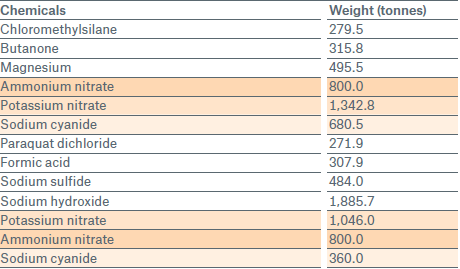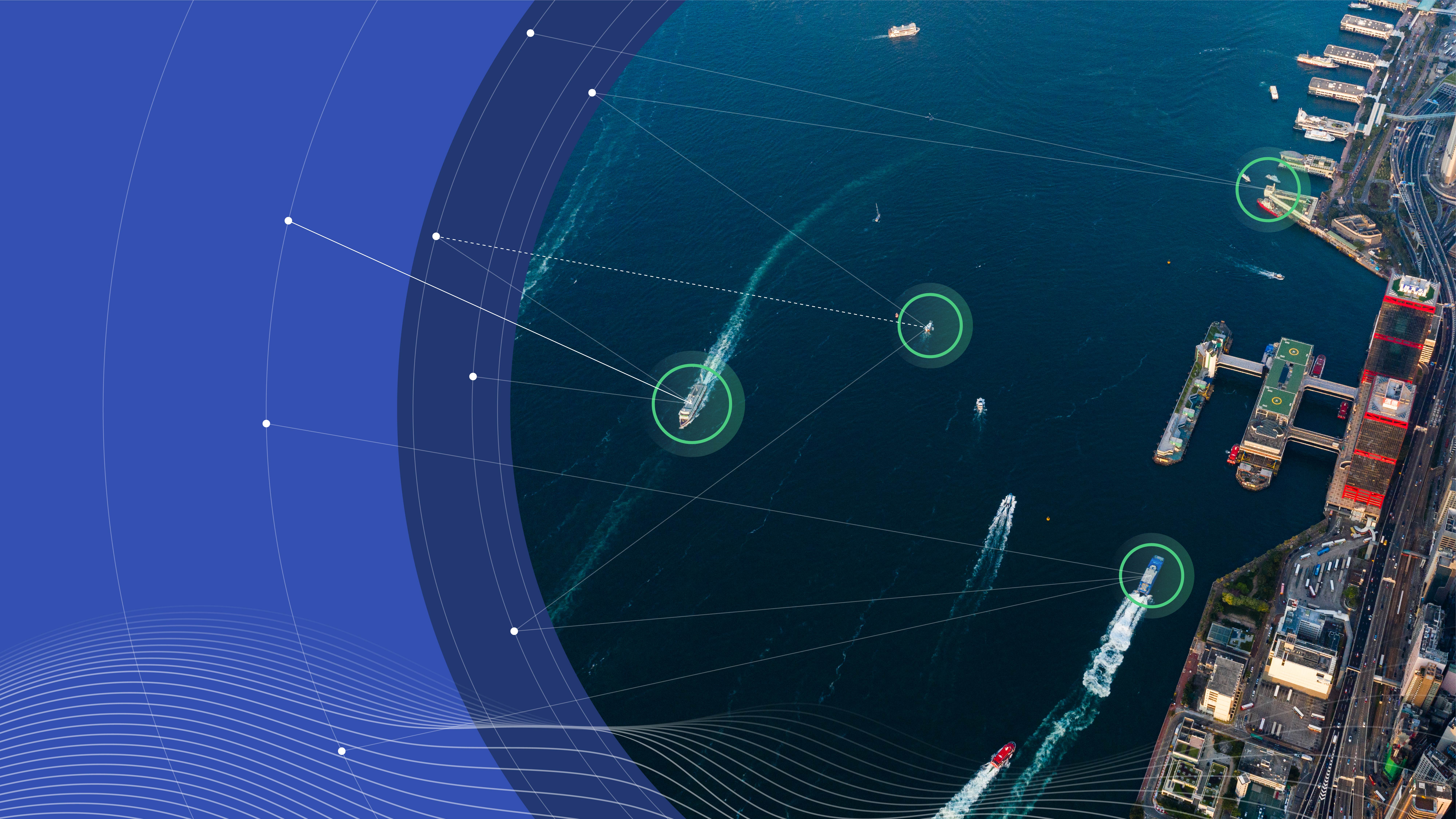The explosion which struck the Chinese city of Tianjin in August 2015 was certainly not the first of its kind, but it was by far the most devastating. The improper storage of hazardous materials can result in explosions that cause enormous damage over a large radius.
Massive explosions shook the Chinese city of Tianjin in the late evening of 12 August 2015. The two most violent blasts ripped a huge crater in the ground, unleashing energy equal to that of earthquakes with a magnitude of 2.3 and 2.9 respectively. According to the official investigation report by the Chinese authorities, the explosive force was equivalent to that of almost 450 tonnes of TNT. The mushroom cloud rose several hundred metres into the sky.
Fire spreads to fertilisers
According to the report, the events were triggered by the spontaneous ignition of cellulose nitrate, also known as nitrocellulose or gun cotton. Containers filled with some 207 tonnes of the substance were located in the storage area of a logistics firm within the port area of Tianjin. A further 27 tonnes were being stored temporarily in the arrival area. The fire then engulfed around 800 tonnes of ammonium nitrate fertiliser, which was being stored nearby, causing it to explode. The resultant crater outside the built-up area indicates that the cellulose nitrate containers were stored out of doors. Investigations revealed that the temperature inside the containers had risen to 65°C following exposure to direct sunlight. As a result, the packages of cellulose nitrate in the containers dried out and finally ignited spontaneously. The investigation report also indicates that the operator of the storage area was holding more than a hundred different hazardous substances there, some in quantities far exceeding the permissible limits. The ten most significant hazardous substances were present in quantities ranging from almost 300 to 2,000 tonnes (see table). All in all, almost 11,400 tonnes of chemicals were located in the dangerous goods warehouse and in the arrival section, plus a further 4,800 tonnes on the site of the logistics firm, including highly toxic and explosive substances. According to the report, 49 people were taken into custody and a further 123 charged with negligence and/or corruption. The accumulation of hazardous substances was evidently due to non-compliance with the regulations.
Chemicals stored in the warehouses at the time of the explosion
The report further states that the explosions and the fire released 129 chemicals which contaminated the air, water and soil in the surrounding area. The air in particular was heavily polluted shortly after the accident. As a result of wind and heat, pollutant concentrations decreased considerably during the next 13 to 18 hours. Extensive chemical contamination was found in a lake some 2.3 km from the scene of the accident; contaminated water also accumulated in the explosion crater and was subsequently discharged into the Gulf of Bohai. In addition, more than 320 tonnes of sodium cyanide, a highly toxic and environmentally harmful chemical, were subsequently reported missing, although the permitted storage limit is only ten tonnes. The deployment of large amounts of hydrogen peroxide after the accident helped to neutralise the remaining sodium cyanide. The rest was rapidly oxidised by atmospheric oxygen and thus rendered harmless.
One of the largest man-made losses in Asia
Munich Re has estimated that the insured market loss could amount to between two and three billion euros, making this one of the largest ever man-made losses in Asia. For insurers and reinsurers, it could also become one of the most complex losses of recent times. According to official reports, 173 people, including 99 firemen, lost their lives or remained unaccounted for and around 800 were injured. The fireball and shock wave from the explosions destroyed containers and caused major damage to warehouses, production facilities and residential buildings. 304 residential, commercial and industrial buildings were damaged, many of them seriously. 7,533 containers and 12,428 imported vehicles were total losses. Windows were shattered, even at a distance of several kilometres. The nearby Donghai metro station was also severely damaged. Even more people would have been killed if the explosions had not occurred in the late evening, and stacked containers had not buffered the force of the blasts. Tianjin port occupies a special position as the gateway to the Beijing region and its facilities have expanded to more than 100 square kilometres in recent years. It is not only the most important terminal in the Beijing region, but also the world's third largest port in terms of tonnage. In light of this rapid growth, precautions to ensure compliance with the regulations on hazardous goods may well have been neglected. As a result of the heterogeneous collection of buildings and industries due to this rapid expansion, several interim storage facilities for up to 75,000 brand new cars – mostly high-quality imports – had sprung up in the immediate vicinity of the chemical store. They also account for the lion's share of the insured loss. The overall loss incurred to the stored goods and containers remains unclear. Around 3,000 containers are believed to be affected. It is unclear whether they contain goods and – if so – what the value of these goods may be. It is likely that many of the containers destroyed and catapulted through the air were empty and stacked in depots.
Property insurance or marine insurance?
Due to the complexity of the subject matter, it will take a long time for the insurers to settle the claims. The first issue to be clarified is whether the damaged vehicles are covered by property insurance or marine insurance. This will depend above all on how the transfer of risk has been defined in the respective policies (quayside or up to the first customer). Correct assignation to property or marine insurance will also determine whether and to what extent deductibles apply, as well as the extent to which any agreed brand protection clauses apply. Predominantly found in marine insurance, these clauses may allow policyholders to claim a total loss in order to protect their brand name, even if damage to insured property is only assumed. Precise determination of the loss is also made more difficult by the fact that the authorities removed thousands of vehicles from the centre of the explosion area immediately after the event and had them destroyed before the loss adjusters were able to start work. Tax and customs issues also remain unanswered. In addition to value-added tax (17% of the vehicles' value), 25% import duty and up to 40% luxury tax (depending on cubic capacity of the engine) are also levied on high-end foreign cars. Exactly which sums apply here in the case of a total or partial loss still has to be established with the Chinese authorities.
Tianjin is not an isolated case
Numerous incidents, some of them many years ago, have highlighted the dangers associated with negligent handling of ammonium nitrate. In 1921, 561 people lost their lives when 4,500 tonnes of ammonium nitrate exploded in a chemical factory in the German town of Oppau. In 1947, a ship carrying ammonium nitrate exploded in the port of Texas City, claiming 581 lives. An industrial accident occurred more recently in Toulouse, on 21 September 2001. Around 300 tonnes of ammonium nitrate detonated in a chemical factory there, killing 31 people and injuring more than 2,300. Dozens of windows, doors and roofs in the area were shattered, leaving 5,000 people homeless. It has still not been possible to establish the cause of the accident. The prosecutors' official theory is that contaminated ammonium nitrate became degraded over the course of many years of exposure to various environmental influences until it finally ignited spontaneously in a container.
There are numerous national and international regulations governing the storage and transport of hazardous goods. The model regulations of the "Recommendations on the Transport of Dangerous Goods" issued by the United Nations establish an international basis for provisions governing hazardous goods. The International Maritime Organization (IMO) has prepared binding safety regulations governing the transport and storage of hazardous goods in ocean shipping; these are recognised to a greater or lesser degree, depending on the country concerned. The International Maritime Dangerous Goods Code (IMDG Code) is a central guideline in this context. However, its regulations remain ineffective if they are disregarded and adequate controls are not enforced.
Business interruption – An underestimated risk
As Enschede, West and Tianjin show, high losses can also occur outside the area directly exposed to an explosion. Scenarios similar to that in Tianjin are also conceivable for other port facilities which have grown rapidly and in an unstructured manner over recent years. The risks in "old" ports, such as Los Angeles, are much lower by comparison. The parties responsible there have learned from past accidents and located potentially dangerous sites in less exposed areas. Tianjin should serve as an example, prompting close scrutiny of the accumulation risks not only in the case of large port facilities, but also for large warehouses and industrial parks. This applies with regard to the concentration of very different types of freight in a narrowly circumscribed area, as well as in respect of the risks presented by industrial enterprises or infrastructure in the surrounding area. What is new is that, in addition to stationary values, attention must increasingly focus on mobile goods and perils. This includes both valuable mobile goods, such as cars, and hazardous mobile goods, such as chemicals. For underwriting purposes, they must be assessed while in motion. This is a demanding task when considering the accumulation risk, for it entails a change of paradigm from purely static modelling to mobile modelling. Efficient information and tracking systems have been developed in the field of telematics to assist the insurance industry when assessing the risks. In future, all parties will have to play their part in making major risks and their interdependencies (supply chains) more transparent, so that such critical risks can be assessed more effectively and prices calculated more efficiently by underwriting teams.
Airborne assessment of the loss
A completely new approach was pursued for the claims handling in Tianjin, where drones and satellites were used for the first time to ascertain the extent of this man-made catastrophe. The satellite data captured all affected cars, containers and buildings, offering valuable information about the extent of the damage. Information provided by satellites was complemented by spatial data captured by copter drones with a resolution (depending on altitude) of just a few centimetres. Combining this spatial knowledge with data mining and web-crawling methods, it was possible to establish links to the individual insured persons. Data from satellites and drones revealed that the Tianjin explosion crater, measuring 100 metres in diameter, was situated outside the built-up storage areas. This led to the conclusion that the chemicals responsible for the explosion must have been stored in the open. Thanks to increasingly high-resolution images and greater amounts of satellite data available, a first swift assessment of the loss from the air will probably become standard procedure for large losses of all kinds.









